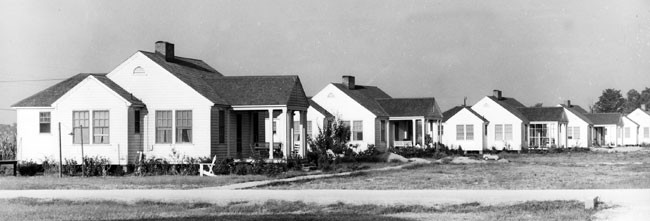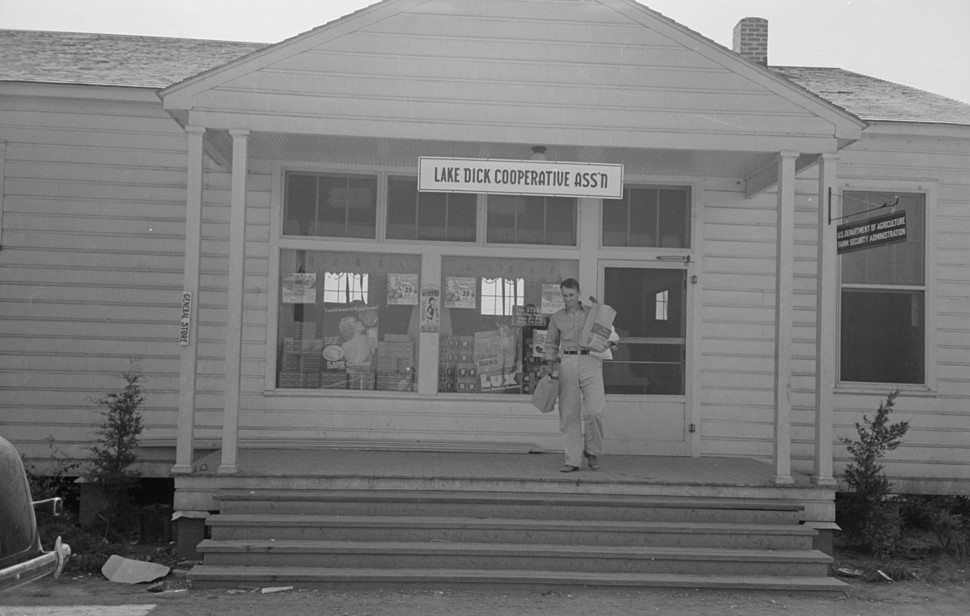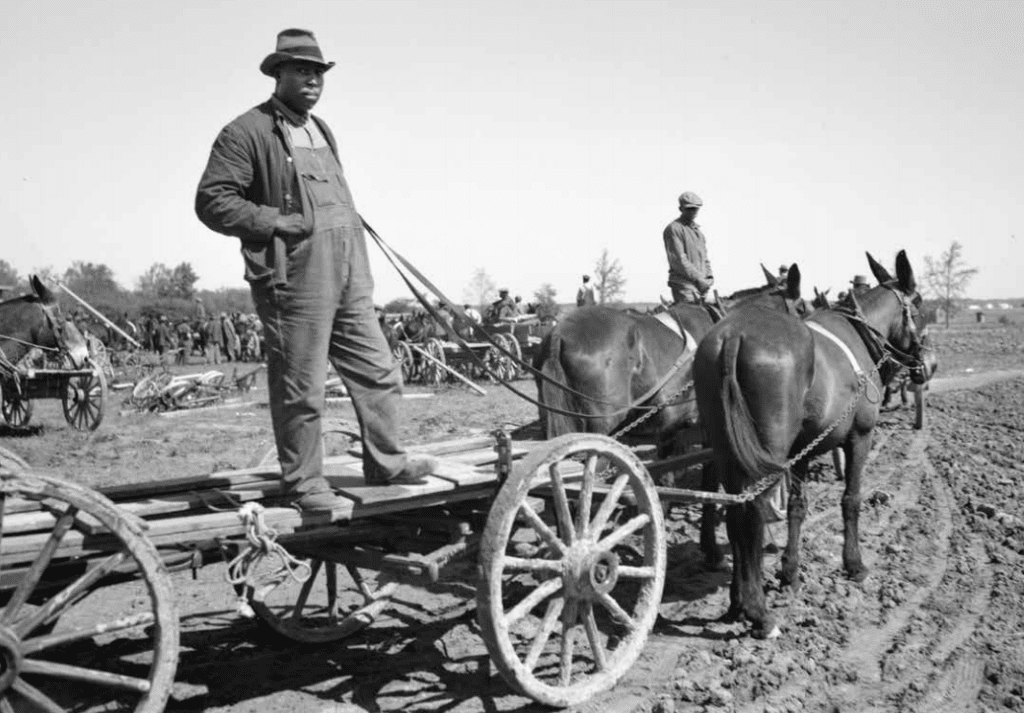In the last Friday Footnote, we looked at how the government’s Resettlement Administration (RA) established migrant labor camps in the west, primarily for displaced farmers from the Dust Bowl region of the U.S. However, hundreds of thousands of farmers all over America were in dire straits from the “Depression Related Farming Pandemic.” So, the RA initiated a different resettlement program to help these farmers – planned farming communities.
About 150 “planned farming communities” were created. However, critics of the plan called them “farm collectives.” and identified them as socialist experiments. One newspaper’s headline about a planned community in Maryland, read: “First Communist Town in America Nears Completion.” Congressional opponents of the program cast the RA’s collectivist resettlement projects as dangerous experiments in socialism. Were they really that bad?
The Resettlement Administration went about the job of relocating farmers to what some people called “collective” farms. However, the structure and organization of the communities varied from location to location with some really being collective farms, but most were closely-knit communities with some cooperative activities.
The federal government bought tracts of land and established these communities. The large tracts of land were typically subdivided into plots of 20-40 acres. Nice but relatively inexpensive houses were built on these plots of land by the government. People applied to live in these planned farming communities. The farmer was able to lease the land with the goal being to own the land.
You had to be married, intelligent, and hardworking, to be considered as a potential farming community resident. Priority was given to those with previous farming experience but who, through no fault of their own, ended up in poverty. There were hundreds of applicants for each plot and the interview/application progress was rigorous.
Let’s go visit three Resettlement Administration communities to see how they worked. I have selected three to show the diversity of these farming communities. A larger sampling of the Rural Administration resettlement projects can be found at https://livingnewdeal.org/new-deal-categories/forestry/resettlement-communities/
Lake Dick, Arkansas – In 1936 the government purchased 3,453 acres surrounding Lake Dick in Jefferson County. The entire Lake Dick farming community was built within a two-year time span. There were eighty (80) 4-6 room houses, six community buildings, and three mule barns. The houses and community buildings were simple one-story white frame buildings. On Sept. 13, 1938 the construction work was finished, and the community was ready for occupancy.

Figure 1. Houses at Lake Dick Resettlement Community
The government selected 80 white farm families from 29 Arkansas counties to be residents. Each family averaged 3.24 persons and had been sharecroppers or tenant farmers. The Lake Dick Cooperative Association was formed with the head of each household holding one share of stock. The Cooperative was responsible for farming the land and operating the community’s cooperative services – the general store, cotton gin, repair shop, feed and grist mill, sweet potato curing house, syrup mill, and meat processing plant. Any excess profits from these enterprises were divided among the community residents.

Figure 2: A farmer leaving the Lake Dick Cooperative General Store.
Each family lived on four acres of land which contained their home, yard, and a small vegetable garden. The crop-producing land was jointly owned and jointly cultivated by all resident families. A cooperative work system was arranged whereby each farmer was assigned a job by the Association’s elected officials. Whether a man worked in the cultivation of the land, raising livestock, cutting timber, or operating one of the community services, he received cash wages bi-weekly from the Association.

Figure 3. Cooperative cultivation at Lake Dick
The wage-earning farmer then paid cash for all goods or services purchased from the Cooperative Association. As a member of this Association, each resident family was eligible for yearly dividends from the excess profits of the Association. Because work was performed cooperatively, each resident of Lake Dick was dependent on other residents for his livelihood.
So, was this experiment a success? According to Mr. E.E. Whittaker, Assistant Director of-the Resettlement Administration’s Region VI (Arkansas, Louisiana, Mississippi) , Lake Dick was much more experimental in nature than the other resettlement farms. Mr. Whittaker reported that with its community ownership and cooperative labor system, Lake Dick was the least successful of the sixteen resettlement projects in Arkansas.
The Lake Dick Cooperative Association was dissolved in 1946 and the land sold to Mr. Ben J. Altheimer of Elm Farms, Inc. The land which once served a socialistic farming cooperative is now owned and operated by a single farming concern. Note: The Lake Dick information was obtained from the National Register of Historic Places application form.
Dyess Colony (Colonization Project Number 1) – Dyess Colony was established in May, 1934, on Mississippi Delta land in northeast Arkansas. It was the first resettlement farming community. The federal government purchased over 16,000 acres of “sunken lands” in Mississippi County and brought in 1,300 men whose names were taken from the relief rolls of Arkansas. These men were put to work building roads and houses. After swamps and marshy areas. were drained and most of the trees cleared, the land was suitable for farming.
Hendricks (2018, Encylopedia of Arkansas) reports that:
The colony was laid out in a wagon-wheel design, with a community center at the hub and farms stretching out from the middle. The roads leading out were simply numbered rather than named, as in “Road 14.” The men dug ditches to drain the land, and they built 500 small farmhouses. Each house had five rooms with an adjacent barn, privy, and chicken coop. The houses were white-washed clapboard, each having two bedrooms, a living room, a kitchen, and a dining room, plus a front and back porch. Apart from these improvements to the land, the colonists were expected to do the rest themselves.
Interviewers from the government were sent to each county in Arkansas to evaluate volunteers, who had to fill out a six-page application form. Families with a farming background from the state’s relief rolls were selected through the application process, which attracted thousands of hopefuls. Criteria for the all-white community included that applicants be destitute from the economic crisis, come from the lowest poverty level, be of “good moral background,” and that husband and wife each have the physical ability to clear the land and farm their acreage. Each farmer would draw a subsistence advance to buy twenty to forty acres of land and one of the new five-room houses, plus a mule, a cow, groceries, and supplies until the first year’s crop came in. [Curator’s Note – 334 farms had 20 acres, 64 farms had 30 acres, and 102 farms had 40 acres. The size farm you were allowed depended on the size of your family). All were expected to pay back the advance. The town would operate as a cooperative in which seed was purchased and crops were sold communally. The families would then receive a share of any profits from the crops and other Dyess businesses, such as the general store and cannery. A local scrip called “doodlum” would be used as currency, and after about three years, when the land had been cleared and the fields were producing, the “licensee” would receive a deed to the house and land after repaying the advance.
In time, along with the administration building, the town center included a community bank, beauty salon/barbershop, blacksmith shop, café, cannery, cotton gin, feed mill, furniture factory, harness shop, hospital, ice house, library, theater, newspaper (the Colony Herald), post office, printing shop, service station/garage, sorghum mill, and school.
The first year at the colony was a trial period for each family, after which they were evaluated by the farm agent and home economist. By 1938 some 115 families had earned deeds to their farms and 300 others had completed the one-year trial and been recommended for retention as colonists. The colonists received loans from the government to buy their plots of land. As the federal loans were repaid the colonists became owners of their own farms.
Although Dyess was not a communal settlement, the colonists did work together on several activities, including the Dyess Theatre, twenty-acre school farm, and joint marketing of truck products. The cotton gin, run by cooperative methods, also provided employment for settlers. The residents had to volunteer time for community tasks in the store, cannery, or cotton gin. The farms were worked individually.

Figure 4. The Dyess Cannery.
The most famous fact about the Dyess Colony was that Johnny Cash was raised here (Farm # 266). His music was greatly influenced by his experiences in Dyess, including such songs as “Pickin’ Time” and “Five Feet High and Rising.” He graduated from Dyess High School in 1950. He was vice president of the senior class and was an officer in the Future Farmers of America.

Figure 5. FFA membership card of Johnny Cash. You will note the name is J. R. His mother wanted to name him John and his father preferred to name him Ray, so J. R. ended up being the only compromise they could agree on. The school yearbook identifies him as J.R. When he enrolled in the Air Force he was not allowed to use just initials so he said John R.
Note: Most of the Dyess Colony information was obtained from the National Register of Historic Places application form and https://encyclopediaofarkansas.net/entries/dyess-mississippi-county-2397/.
Tillery Resettlement Farm (North Carolina) – The Tillery Resettlement Farm was one of the largest resettlement projects in North Carolina and one of only 15 African American projects in the United States (out of approximately 150 projects). The goal for the Resettlement Administration was to have 10% of the homesteaders to be African American which supposedly was their percent in the farming population.
The resettlement farm covered 18,000 acres but was actually two segregated farming communities – Tillery Farm for the African Americans and Roanoke Farms for the white folks. Although plans for 300 farm homesteads were approved, at its peak, the Roanoke/Tillery Farms provided homes for approximately 150 African American Families and about 110 white families in its initial stage.
Originally Tillery was a community of white farmers but when 10,000 acres was flooded by the Roanoke River, the federal government moved the white farmers to an 8,000 acre tract of land on higher ground west of Halifax (NC). When the fields drained, they were sold on credit to African American farmers in parcels of 40-60 acres.

Figure 6. A historical marker recognizing the Tillery Resettlement
Black farmers had two choices of one-story homes — though some moved into two-story homes vacated by whites gone to the Halifax tract. The houses were built of plain wood-frame shiplap, set on sturdy block foundations. A typical farmstead included a house, a smokehouse, an outdoor privy, a barn, and a chicken coop.
Farming tenants were selected through interviews and physical examinations to determine if they were reliable and healthy enough to work the land. They must be family units — a husband and wife, usually with children. The children attended the Tillery Chapel Rosenwald Elementary School — one of 46 Rosenwald Schools in Halifax County.
Settlers on the Tillery Farms Project were initially loaned land, a home, tools, and livestock for three years. In this time, they were expected to learn the basics of farming, home management, and community cooperation. They were expected to follow strict home and farm guidelines, keep a record of expenses, and pay monthly installments toward purchasing their farm. If, after 3 to 5 years, they had demonstrated adequate “interest and potential, ” settlers, gained title to the land, paying the remainder of their loan over a forty-year period.

Figure 7. A farmer in the Tillery Resettlement.
While most settler families came from neighboring counties, some settlers came to Tillery from great distances, as far away as Virginia, Georgia, Florida, and Arkansas.
When the Federal Government liquidated the project in 1943, ninety-three African American settlers had become landowners. In 1947 and 1948, a new group of African American landowners settled on the former resettlement, most buying their property from the government through Farmer’s Home Administration (FmHA) Loans.
Note: Most of the Tillery Resettlement Farm Colony information was obtained from these two web sites – http://www.cct78.org/history-house.html and https://www.ourstate.com/field-of-dreams/.
Concluding Remarks
The Resettlement Administration farming communities were controversial because of their emphasis on cooperation and collective life as a way of improving conditions for America’s small, isolated farm families and tenant farmers. However, for individuals who were able to get established in farming through this program, it was a blessing.
The Resettlement Administration only existed for two years (1935-1937). In the face of Congressional criticism, the Resettlement Administration’s programs were transferred to the newly created Farm Security Administration (FSA) in September of 1937. Even though the RA was abolished many of the resettlement activities continued in the FSA
